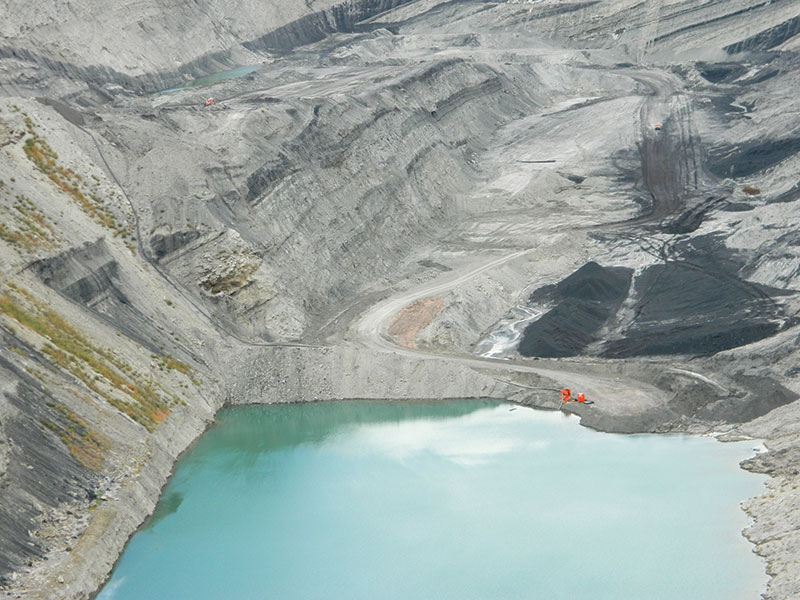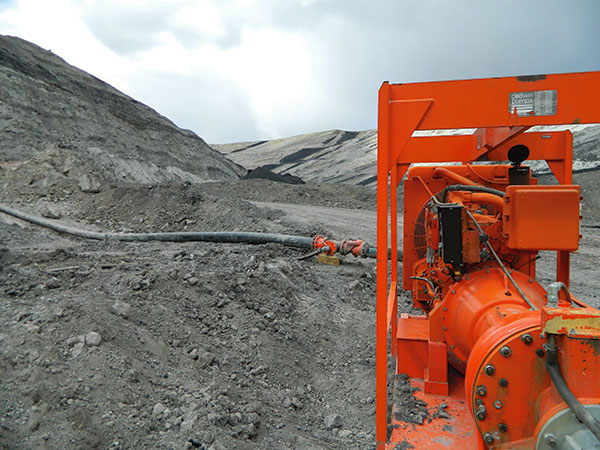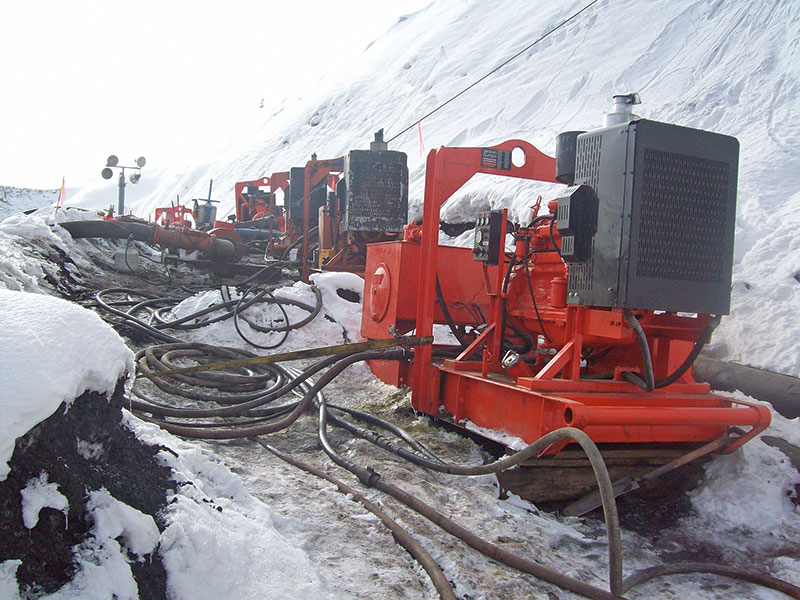Pumps & Systems, March 2013
Mining applications are as diverse as construction or water and wastewater applications. Each jobsite has specific requirements and needs. Underground and open pit mines have several layout and design obstacles. Regardless of the mine and its setup, water is a mine’s biggest enemy.
Getting water out—and keeping it out—is the primary focus of any mine plan. The deeper the mine, the more water that will be encountered and need to be removed. Once dewatering begins, mine planners can get back to what they do best.

A centrifugal pump with a fuel cube
Mine Dewatering
A pump company or dewatering solutions provider can partner with mine planners and engineers in the design and planning stages. A system analysis should be performed first. Then pump selection can begin. Factors to consider in mine planning include portability, easy maintenance and solids-handling.
Another consideration is pH. Pumps can be customized with durable materials of construction specifically designed for low pH and other corrosive liquids.
Pump systems are completely customizable, and the right one can only be selected after the operator or mine engineer understands the mine plan. Pump and piping design and pump control can be tailored to the mine plan. In addition to length of flow, elevation and discharge, consider layout drawings, hydraulic grade lines and pipe wall thickness. Perform friction loss calculations.

A diesel-driven centrifugal pump
Also, consider present and future requirements. A mine’s design can change based on weather conditions, landscape vulnerability and market demands. A dewatering pump company can help design the mine plan, so mine operators and engineers can focus on mining. A reliable dewatering system allows them to continue working.
The power source is another component to consider for mine dewatering pump selection. When selecting a centrifugal pump to fit their needs, many mine operators select diesel-driven centrifugal pumps. As with any other application, operators have options. The initial setup costs should be measured against the lifetime costs of pumping for the project. For a temporary job in a mine or quarry, diesel-driven pumps will typically be the most logical choice. Setup costs are virtually zero. The pumps run on diesel fuel for the short duration of the project. If available near the mine, natural gas is also an option.
Hydraulic submersible pumps are another option for mine planning. These pumps feature a power pack fitted to a submerged pump. The pump ends usually sit at varying levels of submergence, and their power packs sit above ground. They are ideal for abrasive fine sand, high specific gravity (such as that found in slurries) and can offer a total dynamic head up to 600 feet. These hydraulic submersible pumps can be diesel driven or electric, depending on system requirements.

A diesel-driven hydraulic power pack in the foreground (pumps in the background are diesel-driven booster pumps)
Electric-Driven Pumps
If a project is more long-running, consider electric-driven pumps. Electric submersible pumps have a solid history in mining applications. These pumps can handle moderately large flows (up to 2,500 gallons per minute) or extreme high heads (up to 750 feet).
In addition to these submersible pumps, electric-driven centrifugal pumps are ideal for both prolonged temporary pumping and permanent installations. Designed for long-lasting durability, these pumps were initially used in industrial and municipal applications. However, their benefits span many more applications. A permanently installed electric-driven centrifugal pump will provide reliable, continuous pumping and reduced operating and maintenance costs.
While not frequently used in mining applications, electric-driven centrifugal pumps are a viable option for a permanent installation or lengthy temporary pumping job. If the site location is not extremely remote, an electricity source can be found and power lines run to the jobsite. Accessing electricity can outweigh the lifetime costs of a diesel-driven pumping system if the timeframe is long enough. Costs for running electric-driven pumps will eventually be the more economical choice, even factoring in initial setup costs.
For temporary jobs in which refueling is difficult, an electric pump is the ideal solution. Once power lines are established, pump accessibility is almost a nonissue. Lines can be run into underground mines and bolted to the ceiling. Mine planners may not consider this option, but once designed and implemented, electric-driven pumps require less access. They do not need refueling, and their motors require less servicing. These centrifugal pumps also reduce the carbon footprint of any job.
Case Study: Electric-Driven Pumps
A gold mine had an environmental restriction that would no longer allow diesel-driven pumps, which had been operating at their site, provided by a rental company. The mine requested a solution for a portable pumping system that could use the voltage that was available at the tailings dam. The pumps needed to supply 7,500 gallons per minute (gpm) to the roaster facility (the location used to heat the ore and extract the gold) and 4,000 gpm to the autoclave system (similar to the roaster facility, but using pressure along with heat) at the mine.
A pump provider designed a system that used the electricity available onsite. The electro center—the house containing the switch gear, variable frequency drive (VFD) and all the pump controls—was on a portable, structural skid and housed within an enclosure. This unit was placed on the crest of the tailings dam. Using this solution, the company provided three electric-driven, 12-inch centrifugal pumps, each capable of heads up to 390 feet and solids-handling capabilities up to three inches. These pumps provided the necessary flow rates and allowed the system to be moved up-gradient as the tailings levels rose.
Diesel-Driven Pumps
Considering all the benefits of electric-driven pumps, diesel is still the right fit for many mining applications. If no on-site power can be made available, a permanent diesel- or natural gas-driven pump is a great option. Diesel-powered centrifugal pumps come equipped with a diesel engine for stand-alone operation. These pumps will work on any site, no matter how remote. Engines should meet the latest emissions regulations and tier compliance standards.
Standard models of centrifugal pumps are often used for high-volume flow (which can reach 15,000 gpm or more), average total dynamic heads and solids-handling capabilities. Advanced lines of centrifugal pumps are better suited to applications with high or extreme high heads, or those that are used as jetting pumps. The total dynamic head of these pumps, single staged, can reach or exceed 600 feet. This means that, in a mining application, one of these high-head pumps can be sufficient to meet the pumping needs, or great heights can be achieved with just a few pumps staged together.
Safety should always be a consideration. When running diesel-driven centrifugal pumps in an underground mine, air should be vented in to balance the diesel exhaust. This safety condition is eliminated with electric-driven pumps.
A centrifugal pump equipped with a Tier-4 diesel engine
Case Study: Diesel-Driven Pumps
A coal mine needed to dewater its mine floor after a 100-year rain event. All mine operations were stalled. The mine operators needed to get the process back online as quickly as possible. Given the amount of water, the pumps needed to supply 1,100 gpm with 760 feet of total dynamic head.
A solution was designed that required a six-man crew; 15,000 feet of high density polyethylene (HDPE) pipe; two diesel-driven, eight-inch high-head centrifugal pumps; and onsite fusion machines. All equipment was onsite within 10 days of the flood event. The pipe was fused on location, and the mine was quickly operational again.
Conclusion
When water creeps into a mine, it becomes the most important aspect of mine planning. It needs to be dewatered as quickly as possible, but a design also needs to be developed that makes the most sense for the mine. Operators must consider available power sources for the most economical mine plan and reliable mine dewatering system.

